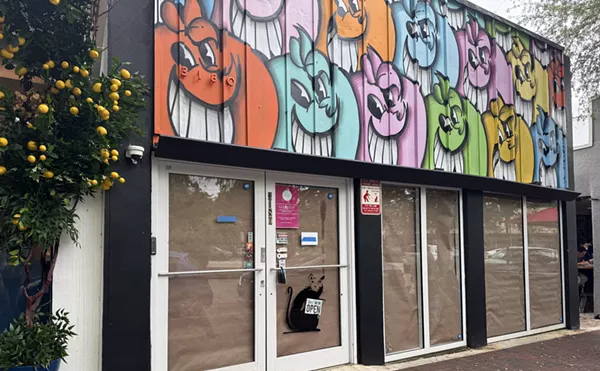Except Albin's. "Some of the agencies always try and throw a ringer onto their teams," he sighs in the world-weary way of someone heading off to the salt mines. He's pretty sure he spotted one of last year's presumed "models" while watching the summer Olympics on TV. And though the fashion world's by-laws on amateur volleyball are still a bit vague, Volleypalooza is for Albin much more than another day at the beach, just as he sees his editorship as infinitely more complex than merely selecting pretty faces to fill Ocean Drive's pages.
"We're never oblivious," he says. "We can't expect to be the only party in town. But Ocean Drive invented this market and we're going to stay the best party around." To the 46-year-old Albin, who cut his publishing teeth as an editor with the New York City-based Interview, his own magazine's monthly paean to all things fabulous follows a highly scientific course. "There's a unique formula that we've got firmly etched in our brains at all times."
Do tell.
"Are you crazy!" Albin laughs. "I'm not going to give it away to you!"
Albin's fears are well grounded. There are no fewer than seven other Miami-based lifestyle mags now circling Ocean Drive like sharks, each trying to steal away -- or at least peel off a chunk of -- that publication's lucrative advertising revenue: Ego Miami, Florida International, Lincoln Road, Loft, Miami Living, Nikki Style, and Vis.a.Vis. And those are just the English-language glossies.
Indeed at that Volleypalooza event last month the advertising sales reps for several of those titles could be spotted taking copious mental notes on what was shaping up to be a shrewd exercise in branding. To the spellbound crowd of onlookers the event may have been an adolescent fantasy come to life, but it was one that was simultaneously plastering Ocean Drive's name on a host of local TV newscasts, as well as garnering it free plugs on national shows such as CSI: Miami, which, thanks to the affair's skewed model to civilian ratio, was hungrily trolling for background footage.
Kulchur spied one ad rep counting off the corporate sponsors present -- from Absolut vodka and Corona beer to the Dodge Viper sports car and the Crunch gym chain -- each paying $20,000 and up for a bannered courtside booth. Midway through the arithmetic he paused, turned to Kulchur, and shook his head with a mixture of disbelief and awe: "Now this is how you run a business!"
"Everybody thinks they can get a piece of you," grumbles Jerry Powers, sitting inside his Ocean Drive office above the Beach's Washington Avenue. More than a decade on from its January 1993 debut, Powers, Ocean Drive's publisher and majority owner, says the magazine saw 2004 revenues of $14 million with a profit of $3 million, up 30 percent from the previous year. Clearly those numbers, inflated or not, are inspiring a fresh legion of celebrity-chasing hopefuls.
Kulchur begins ticking off the names of Powers's current competition, all seeking to attract and chronicle the city's glitterati via a similar template: On the cover, feature a model offering up her best "come hither" gaze, follow it with an interview of a B-list starlet, then a chat with the C-list actress whose publicist you had to appease to land the B-lister, sprinkle in a few risqué fashion layouts, add a full brace of party pictures, and voilà! You're a Miami publishing mogul!
"Well, it's not that easy!" Powers protests. He has his own list of names to reel off, twelve years of failed rivals such as South Beach, Fashion Spectrum, Channels, and Miami Metro. "I've got copies of them all that I keep at home," he adds pointedly, conjuring up an image of glossy corpses mounted like stuffed trophies around his living room. "These people roll into town, think you can just hire a writer, grab some models, and then go out and sell ads. It doesn't work like that."
Except that's exactly how Ocean Drive began in 1993, when Powers says he and co-publisher Jason Binn launched with $27,000 in seed money and little else but chutzpah. "We didn't even have an office then," he recalls. "We planned the whole first issue at the back table of the News Café." Growing excited at the memory, Powers, with a youthful energy that belies his 58 years, jumps up and retrieves a tattered mockup of his second issue from behind his desk. Its pages are entirely blank except for penciled-in names: Betsey Johnson, Diesel, the Strand, the Spot -- clothing lines, restaurants, and nightclubs he was sure would be clamoring to advertise. With that attitude, he hit the tony boutiques of the Bal Harbour Shops, schmoozing and wheedling his way into their managers' checkbooks: "We so believed in the vision of this magazine that you were either going to call the guy with the dogcatcher net to come take us away, or you believed right along with us."
Cash flow was tight in those early days, Powers says, and finances were often hand-to-mouth -- which led to recapitalization from three main investors: Manhattan marketing executive Michael Warren, notorious German playboy and real estate developer Thomas Kramer, and the late Derick Daniels, a former Miami Herald editor, Knight Ridder executive, and the late-Seventies president of Playboy largely credited with rescuing that magazine from impending bankruptcy, and then helping steer it into the cable TV and home-video fields that keep it afloat today.
Looking back on that founding crew, opinion is divided on apportioning credit for Ocean Drive's success. Certainly its timing was key, offering a promotional vehicle that mirrored South Beach's media-drenched rise through the Nineties as an international hot spot.
Talk to advertisers in New York, though, and it's the moxie of Jason Binn that often gets cited, a blend of tireless fixer hitched to a spirit of salesmanship that involved everything short of promising his first-born. "What Mr. Binn does is make life easier for the well-known," noted Andrew Goldman in a New York Observer profile. "Whenever a celebrity is feeling down, beating himself up, or needing to be surrounded by a battalion of very friendly six-foot-tall blondes, Mr. Binn, it seems, will be there. In a world of James Deans, someone's got to play the Sal Mineo part. "
These days Binn is rarely in Miami, devoting the bulk of his time to newer publishing ventures, such as New York's Gotham and Hamptons. Yet it's the lesser-known role of Derick Daniels that still intrigues. Powers is quick to credit Daniels with schooling him on the finer aspects of his nascent magazine's design, of seeing the publication as less a collection of articles than a new "mini movie" readers could envision themselves inside every month.
"Ocean Drive shall never have jump pages," he repeats, as if intoning a mantra drilled into him -- you'll never find yourself flipping from, say, page 70 to page 183 to continue reading a story. But it was in shaping Ocean Drive's overall aesthetic -- that secret editorial formula -- that Daniels seems to have left his biggest imprint. Although Daniels's Playboy of the Seventies found itself losing circulation to more explicit upstarts such as Hustler and Penthouse, Daniels always kept his magazine's own centerfolds surrounded by high-brow fare. And while Playboy's Norman Mailer pieces gave rise to the dubious claim of "only reading it for the articles," they also kept Playboy publicly acceptable to wealthier readers -- whatever their justification for subscribing -- as well as the luxury advertisers eager to reach them.
Much the same formulation propels Ocean Drive today as it sashays up to, but never crosses, the line of titillation. Binn told the New York Times that his magazine's guiding personality is sex, period. But unlike the fashion pieces in Loft, the most high-profile of its local competitors, in Ocean Drive you'll never see a woman's exposed nipple -- let alone the cover shot of MTV Latin America VJ Eglantina Zingg tied to a chair that graced Loft last year.
Of course, once inside Ocean Drive's hefty 442-page February issue, you'll have to slog through 133 pages of condo ads, many of which make it unclear whether you're being asked to buy a two-bedroom penthouse unit or the semiconscious woman photographed on its floor. And to arrive at its entertainingly snarky gossip columns, you'll have to avoid being distracted by the fashion spread of leggy Amazonian Bruna Magagna doing something atop the Dogma Grill's hot dog counter that borders on a health-code violation. But surely you're reading Ocean Drive for the articles, not the pictures.
"This is a coffee-table book," Powers says of Ocean Drive, one whose cover will always look at home atop an issue of Town and Country -- even if few of its audited 55,000 readers are actually paying for their copies.
"They made controlled circulation sexy," explains Samir Husni, a publishing industry analyst and chairman of the journalism department at the University of Missouri, referring to the bulk of Ocean Drive's targeted free distribution. "Controlled circulation in the good old days was for a specific audience. If you were a black chemical engineer, then you would get a copy of Black Chemical Engineer Monthly in the mail. What Ocean Drive said is, öIf you are somebody who "counts," if you are part of the cream of the crop, we are going to make sure that you see this magazine. And not only see this magazine, but also see yourself in this magazine.' So they had two strokes of the ego of the reader, and that's become just as attractive to advertisers. It's why you see so many imitators growing up like wild mushrooms."
"It's an ego trip," says Corey Augenstein of the motivation behind the current glut of Miami lifestyle magazines. And he should know. As publisher of the short-lived Collins Avenue, Augenstein produced his debut issue this past May. Then, having burned through what he estimates was $100,000 with virtually no ad sales, he pulled the plug.
"Everybody wants to be a player down here. You become the publisher of a magazine, you get into every party that exists in mankind," he recalls of his brief stint on the VIP list. "You'll meet women, men, whatever you're interested in. You'll rub elbows with celebrities, people will bend over backward to get written about. You can have a great life just by putting your name on a rag. That's why you see so many new magazines popping up every day."
Augenstein is quick to lambaste the "total incompetence" of his sales staff -- "they couldn't even give away ads!" -- but ultimately, he says, "I blame myself for all this. I got in way over my head. Too many positive seeds were planted in my head that this was a no-brainer." For now it's back to the Websites he quietly runs, which offer tutorials on succeeding in the field of "midlevel marketing."
Of course, when Kulchur first met Augenstein a year ago, he was delivering a far less humble spiel. Holding court at last spring's annual Wolfsonian Museum gala, he was full of grand plans. Ocean Drive was a "worthless product" coasting on its reputation, he brashly declared, while his own magazine was poised to become "the essence of class, distinction, affluence, and style."
Stepping outside downtown's Alfred I. Dupont building to smoke a cigarette on the street below, he continued to detail the many ways his own venture would squash the competition: "I know all about the publishers who are in it just to get laid. This isn't about fitting into a certain social circle for me."
As if on cue, a statuesque blonde exited the gala with her husband. Spying Augenstein, she approached, eyes glaring. "What did you say to me before?" she huffed as her visibly enraged husband stood beside her, his hands clenched into fists.
"I, uh, was trying to tell you you're very beautiful," Augenstein stammered, his eyes darting between the scowling husband and Kulchur's note-taking pen.
"Well, you've got a funny way of saying it!" she snapped.
Augenstein inched backward, weighing his options, until the husband decided he'd had enough. "Peace and love," he muttered, grabbing his wife's hand and leading her off to a waiting cab.
So what was your big pick-up line? Did you tell her you owned a magazine?
"Oh, that's not important," Augenstein blushed. Then, pausing for only a few beats, he regained his composure. Did Kulchur truly understand just how "unique" Collins Avenue was going to be?
Wounded pride aside, Augenstein can take comfort in knowing he's merely one in a long line of would-be machers with dreams of taking on Jerry Powers. Hitting the streets at roughly the same time as Ocean Drive in early 1993 was South Beach, a similar collection of scantily clad gamines, fashion tips, and party pictures. In less than a year its founders, Paul and Katherine Arthaud, closed up shop, having blown nearly a million dollars.
Fashion Spectrum was the next deep-pocketed contender to arrive in 1996, helmed by Venezuelan-born venture capitalist Franco Pizzorni, who delighted in tweaking Jerry Powers via a series of barbed ads. "They went head-to-head with us for events," remembers Ocean Drive senior account executive Michele Addison. "Every week there was another huge party. I can't even imagine how much money they were spending on it all."
Aside from penning a series of bizarre columns about his UFO sightings and his fears of creeping Satanism, Pizzorni seemed to have little enthusiasm for the less ethereal nuts and bolts of putting out a magazine. While he was more than happy to open his North Bay Road waterfront mansion for a Miss Universe fete, Fashion Spectrum editor Lori Capullo complained to the Daily Business Review that she could never persuade her boss to concentrate on actually acquiring subscribers. Another ex-Fashion Spectrum staff member sighed to Kulchur that "we could never get Franco to show up in the office for editorial meetings. But if we had a cattle call of models coming in for a photo shoot, he'd be the first person there. "
Apparently tiring of the financial drain, Pizzorni folded his publication in July 1998. But his employees didn't have to wait long for a new patron hoping to cut a dramatic profile. Just one month later, having hit town amid a flurry of well-publicized art purchases and philanthropic contributions, New York stockbroker Richard Bronson added to his portfolio by hiring Capullo and eleven of Fashion Spectrum's fifteen staffers to launch the nearly identical Channel.
Another magazine, another year of model-clogged parties. By 1999 Channel had become Channels, a tribute to Bronson's expanding vision, and given Bronson's subsequent SEC banishment from Wall Street over charges of defrauding investors, a convenient way of dodging the publication's growing list of creditors. January 2000 saw the magazine sold to Chris Olsen and Brad Rosenblatt, who, after changing its name to Channels International, losing some $750,000, and filing a series of lawsuits against each other, would in turn sell the venture to Sheriff Ishak in October. Ishak eked out another year with the requisite dose of "supermodel search contests" before decamping to Manhattan, where he now publishes Zink. (Bronson is currently serving two years in prison for securities fraud.)
One would think that this track record might dissuade even the hardiest aspiring Miami media titan. And yet, after losing out to Ishak in his bid to buy Channels International, telecom millionaire Shawn Lewis remained undaunted, bankrolling the party-picture-packed Ego Trip as a way to spotlight his string of South Beach nightclubs. Having supposedly lost his fortune in the wake of 2000's dot-com stock crash (and several disastrous margin calls), a blasé Lewis flew to Los Angeles for a November 2001 courthouse child-support hearing. There Lewis testified he'd written off his $350,000 investment in Ego Trip -- "you can't get blood from a stone" -- since the publication was near collapse. This despite also having hired publicist Ingrid Casares to the tune of $8000 per month to help promote his various projects.
With all that history in mind, one wonders just how well today's Beach publishers are faring beyond the glowing press releases and paparazzi-laden shindigs. "You'll see great ads in the beginning with these magazines," cautions the media liaison for one Miami public-relations firm, "which entices other people to advertise -- öOh, you've got two pages from Cartier! Gucci is in there! Bulgari!' But a lot of people don't realize those ads are given away for free. A lot of my clients are happy to get the free press, but look a few months later and see who's still there."
You won't hear of such dampened spirits over at Lincoln Road, where (shades of Corey Augenstein) "unique" is the buzzword on everyone's lips. Their audited circulation may be only 28,900, and editor in chief Denise Sypesteyn declines to reveal their 2004 revenues, but she points to Lincoln Road's recent upgrade from a bimonthly to ten issues per year: "If we weren't on target with our projections, we wouldn't be able to do that."
Loft's audited circulation is also anemic at 28,000, though its executives note that separate editions have already been launched in New York and Los Angeles. And while advertising beyond real estate projects remains sparse, Loft seems to be having little trouble finding eager backers willing to bet on its future -- at least if a recent multimillion-dollar preferred-stock offering is any indication. Nikki Style publisher Peter Higney is likewise upbeat, trotting out the now de rigueur "unique" as he describes his product. While Higney's claim of having a circulation of 30,000 seems a bit high (Nikki Style is unaudited), he touts his magazine's international appeal, given its tie-in to the eight Nikki Beach clubs and resorts around the globe, from Miami to St. Tropez.
A rare note of realism comes from Ego Miami co-owner David Bick, previously known for his stewardship of Lola Bar on South Beach. "We keep our costs low, none of us drives Porsches," Bick quips of his co-workers at the Ego Trip spinoff. The key to thriving, he continues, is to avoid a head-on confrontation with Ocean Drive while grasping for the low-hanging fruit its marketplace jockeying leaves behind. "There are still lots of very cool fashion shops that want to be next to Michael Stipe and Gwen Stefani," he explains, pointing to two of his recent cover subjects, "but who can't afford to pay $4000 for an ad in Ocean Drive."
Bick also confronts a grim daily reminder of how important it is to keep Ego Miami's own ego in check: "Collins Avenue magazine used to be in the office right next door to us."
Back at Ocean Drive, Kulchur asks Jerry Powers to consider his own publishing career -- there must have been some stumbles along the way. Why has his magazine grown while so many others have disappeared from Miami? What exactly does he know that Franco Pizzorni or Richard Bronson didn't?
"Oh, it's my MBA from Harvard, my business-school experience," he answers, deadpan, before cracking up. Powers has worn many pre-Ocean Drive identities, from Sixties rebel to Eighties art dealer, but none of them involves the mantle of a strait-laced CEO. Indeed the transition from Yippie to Yuppie was anything but smooth, involving drug arrests, writing bad checks, and pleading guilty to the IRS for failing to file tax returns for two years. All of which seems very distant from his current position running a phone-book-size publishing phenomenon with 54 full-time employees.
"What did Sinatra say?" Powers muses. Tilting his head to the side, he smiles and begins playfully crooning the chorus of "That's Life": "I've been a puppet, a pauper, a pirate, a poet, a pawn, and a king. "
Kulchur gently breaks into the reverie, mentioning Powers's October 2004 cover choice of presidential aspirant John Kerry's daughter Alexandra, a decision that raised more than a few eyebrows.
"That was a mistake," Powers concedes, repeating the words several times, reminding himself as much as Kulchur. Not that Alexandra Kerry was a handful. "Unlike Paris Hilton, she showed up for her shoot on time," he jokes. "I didn't have to worry she was out somewhere the night before getting too loaded." And compared to the hulking security crews many stars travel with, the Secret Service agents who accompanied Alexandra were relatively unobtrusive as they flitted around his office.
Neither was Powers concerned that Alexandra didn't look the part of a cover girl. She certainly appeared demure enough in her feature layout. And though Powers took a bit of ribbing over Alexandra's decrying of George W. Bush's elitist economic policies while decked out in an Yves Saint Laurent top and Gucci heels (not the most effective argument against her dad's perceived "limousine liberalism"), he's well acquainted with the parameters of radical chic.
As publisher of Miami's Vietnam-era Daily Planet underground newspaper, Powers did advance work for Jerry Rubin and Abbie Hoffman at the Beach's 1972 Republican National Convention, where he dodged tear-gas canisters and police charges while arranging TV and radio interviews for the two protest leaders.
But these days Powers is a pillar of the very establishment he once railed against. And with so many of Miami's power brokers -- from real estate kings to auto magnates -- cementing their ties to the Bush family, particularly with the term-limited Gov. Jeb Bush's expected return to town as a partner with über developer Armando Codina, choosing political sides can be bad for business. "I just wanted to spend a night in the Lincoln bedroom," Powers says with a sheepish shrug, referring to his Kerry boosterism.
Powers may yet score that White House sleepover -- if he's willing to wait out the Bush presidency. After all, Jason Binn has already been spotted gallivanting around New York City with Hillary Clinton's hubby Bill. Moreover to hear analyst Samir Husni tell it, the culture at large is trending Powers's way.
"We're just seeing the tip of the iceberg with Ocean Drive. It isn't just Florida now," Husni observes. "It's a business model that works, and when it comes to magazine publishing, we are a nation of imitators." Accordingly, though he believes Miami is oversaturated, he has advice for those seeking to follow Powers's lead in chronicling the luxe life: Have you considered Orlando? "You won't be able to escape these types of publications in any city you go to in the entire United States of America."
On that note, Powers's newest magazine, Vegas, seems a natural fit for a burg that can often make Miami look subdued. But Binn's impending launch of glossies in Boston and Washington, D.C., cities where conspicuous consumption was once frowned upon, at least beyond closed doors, would seem to augur a change in the air.
So it's going to be an Ocean Drive world? Eventually every town will have its own velvet-rope bashes, its own crowd of beautiful people, and its own slick magazine to immortalize it all? Even Indianapolis?
"Definitely," Husni laughs, "but in Indianapolis it's not going to be called Indie Drive." Then he stops and reconsiders: "Actually that may work for the NASCAR fans."












